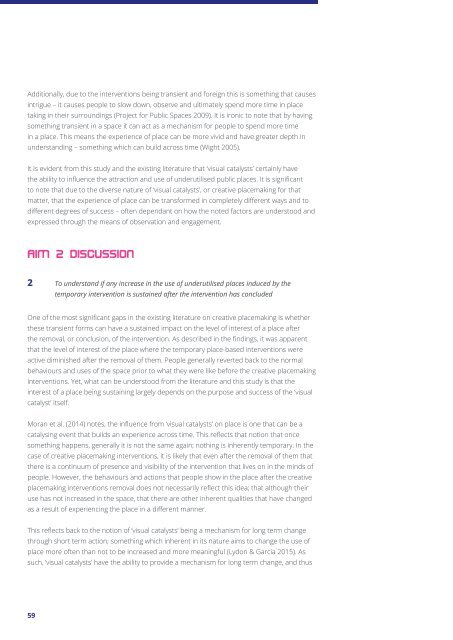Exploring the Role of 'Visual Catalysts' on Influencing People's Attraction and Use of Place
Undergraduate Thesis // Keegan Lovell // Bachelor of Landscape Architecure // UNSW 2016
Undergraduate Thesis // Keegan Lovell // Bachelor of Landscape Architecure // UNSW 2016
You also want an ePaper? Increase the reach of your titles
YUMPU automatically turns print PDFs into web optimized ePapers that Google loves.
Additi<strong>on</strong>ally, due to <str<strong>on</strong>g>the</str<strong>on</strong>g> interventi<strong>on</strong>s being transient <strong>and</strong> foreign this is something that causes<br />
intrigue – it causes people to slow down, observe <strong>and</strong> ultimately spend more time in place<br />
taking in <str<strong>on</strong>g>the</str<strong>on</strong>g>ir surroundings (Project for Public Spaces 2009). It is ir<strong>on</strong>ic to note that by having<br />
something transient in a space it can act as a mechanism for people to spend more time<br />
in a place. This means <str<strong>on</strong>g>the</str<strong>on</strong>g> experience <str<strong>on</strong>g>of</str<strong>on</strong>g> place can be more vivid <strong>and</strong> have greater depth in<br />
underst<strong>and</strong>ing – something which can build across time (Wight 2005).<br />
It is evident from this study <strong>and</strong> <str<strong>on</strong>g>the</str<strong>on</strong>g> existing literature that ‘visual catalysts’ certainly have<br />
<str<strong>on</strong>g>the</str<strong>on</strong>g> ability to influence <str<strong>on</strong>g>the</str<strong>on</strong>g> attracti<strong>on</strong> <strong>and</strong> use <str<strong>on</strong>g>of</str<strong>on</strong>g> underutilised public places. It is significant<br />
to note that due to <str<strong>on</strong>g>the</str<strong>on</strong>g> diverse nature <str<strong>on</strong>g>of</str<strong>on</strong>g> ‘visual catalysts’, or creative placemaking for that<br />
matter, that <str<strong>on</strong>g>the</str<strong>on</strong>g> experience <str<strong>on</strong>g>of</str<strong>on</strong>g> place can be transformed in completely different ways <strong>and</strong> to<br />
different degrees <str<strong>on</strong>g>of</str<strong>on</strong>g> success – <str<strong>on</strong>g>of</str<strong>on</strong>g>ten dependant <strong>on</strong> how <str<strong>on</strong>g>the</str<strong>on</strong>g> noted factors are understood <strong>and</strong><br />
expressed through <str<strong>on</strong>g>the</str<strong>on</strong>g> means <str<strong>on</strong>g>of</str<strong>on</strong>g> observati<strong>on</strong> <strong>and</strong> engagement.<br />
AIM 2 DISCUSSION<br />
2 To underst<strong>and</strong> if any increase in <str<strong>on</strong>g>the</str<strong>on</strong>g> use <str<strong>on</strong>g>of</str<strong>on</strong>g> underutilised places induced by <str<strong>on</strong>g>the</str<strong>on</strong>g><br />
temporary interventi<strong>on</strong> is sustained after <str<strong>on</strong>g>the</str<strong>on</strong>g> interventi<strong>on</strong> has c<strong>on</strong>cluded<br />
One <str<strong>on</strong>g>of</str<strong>on</strong>g> <str<strong>on</strong>g>the</str<strong>on</strong>g> most significant gaps in <str<strong>on</strong>g>the</str<strong>on</strong>g> existing literature <strong>on</strong> creative placemaking is whe<str<strong>on</strong>g>the</str<strong>on</strong>g>r<br />
<str<strong>on</strong>g>the</str<strong>on</strong>g>se transient forms can have a sustained impact <strong>on</strong> <str<strong>on</strong>g>the</str<strong>on</strong>g> level <str<strong>on</strong>g>of</str<strong>on</strong>g> interest <str<strong>on</strong>g>of</str<strong>on</strong>g> a place after<br />
<str<strong>on</strong>g>the</str<strong>on</strong>g> removal, or c<strong>on</strong>clusi<strong>on</strong>, <str<strong>on</strong>g>of</str<strong>on</strong>g> <str<strong>on</strong>g>the</str<strong>on</strong>g> interventi<strong>on</strong>. As described in <str<strong>on</strong>g>the</str<strong>on</strong>g> findings, it was apparent<br />
that <str<strong>on</strong>g>the</str<strong>on</strong>g> level <str<strong>on</strong>g>of</str<strong>on</strong>g> interest <str<strong>on</strong>g>of</str<strong>on</strong>g> <str<strong>on</strong>g>the</str<strong>on</strong>g> place where <str<strong>on</strong>g>the</str<strong>on</strong>g> temporary place-based interventi<strong>on</strong>s were<br />
active diminished after <str<strong>on</strong>g>the</str<strong>on</strong>g> removal <str<strong>on</strong>g>of</str<strong>on</strong>g> <str<strong>on</strong>g>the</str<strong>on</strong>g>m. People generally reverted back to <str<strong>on</strong>g>the</str<strong>on</strong>g> normal<br />
behaviours <strong>and</strong> uses <str<strong>on</strong>g>of</str<strong>on</strong>g> <str<strong>on</strong>g>the</str<strong>on</strong>g> space prior to what <str<strong>on</strong>g>the</str<strong>on</strong>g>y were like before <str<strong>on</strong>g>the</str<strong>on</strong>g> creative placemaking<br />
interventi<strong>on</strong>s. Yet, what can be understood from <str<strong>on</strong>g>the</str<strong>on</strong>g> literature <strong>and</strong> this study is that <str<strong>on</strong>g>the</str<strong>on</strong>g><br />
interest <str<strong>on</strong>g>of</str<strong>on</strong>g> a place being sustaining largely depends <strong>on</strong> <str<strong>on</strong>g>the</str<strong>on</strong>g> purpose <strong>and</strong> success <str<strong>on</strong>g>of</str<strong>on</strong>g> <str<strong>on</strong>g>the</str<strong>on</strong>g> ‘visual<br />
catalyst’ itself.<br />
Moran et al. (2014) notes, <str<strong>on</strong>g>the</str<strong>on</strong>g> influence from ‘visual catalysts’ <strong>on</strong> place is <strong>on</strong>e that can be a<br />
catalysing event that builds an experience across time. This reflects that noti<strong>on</strong> that <strong>on</strong>ce<br />
something happens, generally it is not <str<strong>on</strong>g>the</str<strong>on</strong>g> same again; nothing is inherently temporary. In <str<strong>on</strong>g>the</str<strong>on</strong>g><br />
case <str<strong>on</strong>g>of</str<strong>on</strong>g> creative placemaking interventi<strong>on</strong>s, it is likely that even after <str<strong>on</strong>g>the</str<strong>on</strong>g> removal <str<strong>on</strong>g>of</str<strong>on</strong>g> <str<strong>on</strong>g>the</str<strong>on</strong>g>m that<br />
<str<strong>on</strong>g>the</str<strong>on</strong>g>re is a c<strong>on</strong>tinuum <str<strong>on</strong>g>of</str<strong>on</strong>g> presence <strong>and</strong> visibility <str<strong>on</strong>g>of</str<strong>on</strong>g> <str<strong>on</strong>g>the</str<strong>on</strong>g> interventi<strong>on</strong> that lives <strong>on</strong> in <str<strong>on</strong>g>the</str<strong>on</strong>g> minds <str<strong>on</strong>g>of</str<strong>on</strong>g><br />
people. However, <str<strong>on</strong>g>the</str<strong>on</strong>g> behaviours <strong>and</strong> acti<strong>on</strong>s that people show in <str<strong>on</strong>g>the</str<strong>on</strong>g> place after <str<strong>on</strong>g>the</str<strong>on</strong>g> creative<br />
placemaking interventi<strong>on</strong>s removal does not necessarily reflect this idea; that although <str<strong>on</strong>g>the</str<strong>on</strong>g>ir<br />
use has not increased in <str<strong>on</strong>g>the</str<strong>on</strong>g> space, that <str<strong>on</strong>g>the</str<strong>on</strong>g>re are o<str<strong>on</strong>g>the</str<strong>on</strong>g>r inherent qualities that have changed<br />
as a result <str<strong>on</strong>g>of</str<strong>on</strong>g> experiencing <str<strong>on</strong>g>the</str<strong>on</strong>g> place in a different manner.<br />
This reflects back to <str<strong>on</strong>g>the</str<strong>on</strong>g> noti<strong>on</strong> <str<strong>on</strong>g>of</str<strong>on</strong>g> ‘visual catalysts’ being a mechanism for l<strong>on</strong>g term change<br />
through short term acti<strong>on</strong>; something which inherent in its nature aims to change <str<strong>on</strong>g>the</str<strong>on</strong>g> use <str<strong>on</strong>g>of</str<strong>on</strong>g><br />
place more <str<strong>on</strong>g>of</str<strong>on</strong>g>ten than not to be increased <strong>and</strong> more meaningful (Lyd<strong>on</strong> & Garcia 2015). As<br />
such, ‘visual catalysts’ have <str<strong>on</strong>g>the</str<strong>on</strong>g> ability to provide a mechanism for l<strong>on</strong>g term change, <strong>and</strong> thus<br />
59


